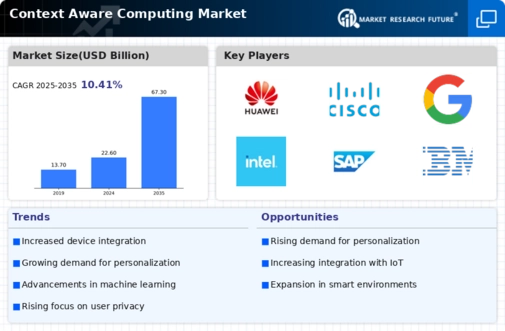The Context Aware Computing Market is currently characterized by a dynamic competitive landscape, driven by rapid technological advancements and increasing consumer demand for personalized experiences. Major players such as Google (US), Apple (US), and Microsoft (US) are at the forefront, each adopting distinct strategies to enhance their market positioning. Google (US) focuses on integrating artificial intelligence into its context-aware applications, thereby enhancing user engagement and satisfaction. Apple (US), on the other hand, emphasizes privacy and security in its context-aware solutions, appealing to a consumer base increasingly concerned about data protection. Microsoft (US) leverages its cloud computing capabilities to offer scalable context-aware services, which positions it favorably in enterprise markets. Collectively, these strategies not only intensify competition but also foster innovation, pushing the boundaries of what context-aware computing can achieve.
In terms of business tactics, companies are increasingly localizing manufacturing and optimizing supply chains to enhance efficiency and responsiveness to market demands. The competitive structure of the Context Aware Computing Market appears moderately fragmented, with a mix of established tech giants and emerging startups. This fragmentation allows for diverse approaches to innovation and customer engagement, as key players strive to differentiate themselves in a crowded marketplace.
In August 2025, Google (US) announced the launch of its new AI-driven context-aware platform, which aims to revolutionize user interaction by providing real-time, personalized content based on user behavior and preferences. This strategic move is significant as it not only reinforces Google's commitment to AI but also positions the company to capture a larger share of the growing demand for personalized digital experiences.
In September 2025, Apple (US) unveiled its latest context-aware features in the iOS ecosystem, which include enhanced location-based services that prioritize user privacy. This development is crucial as it aligns with the increasing consumer demand for privacy-centric solutions, potentially giving Apple a competitive edge in a market where data security is paramount.
In October 2025, Microsoft (US) expanded its Azure cloud services to include advanced context-aware computing capabilities, enabling businesses to leverage real-time data analytics for improved decision-making. This expansion is indicative of Microsoft's strategy to integrate context-aware computing into its broader cloud offerings, thereby enhancing its value proposition to enterprise clients.
As of October 2025, the competitive trends in the Context Aware Computing Market are increasingly defined by digitalization, sustainability, and the integration of artificial intelligence. Strategic alliances among key players are shaping the landscape, fostering collaboration that enhances technological capabilities and market reach. Looking ahead, competitive differentiation is likely to evolve from traditional price-based competition to a focus on innovation, technological advancement, and supply chain reliability, as companies strive to meet the sophisticated demands of consumers and businesses alike.

















Leave a Comment